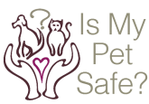Kid treats are dangerous pet treats
It's the spooky time of year again and while great fun for kids and adults who act like kids, Halloween can be a frightening, even deadly, time to be a pet. Unfortunately, a lot of those candy treats we humans love so much are also tempting for our furry friends.

Before going any further, here are the two things you should do today, prior to Halloween:
- Put the name and phone number of your regular vet as well as the vet closest to your home on your refrigerator door,
- Explain to your children that while sweets are OK for them, their treats are very dangerous to your dog, can make him very sick and (if they are old enough to hear), may kill him. Make sure they understand not to give the dog any of their treats and not to leave treats unattended anywhere the dog may get them.
Please note, I am not being anti-feline today. Truth be told, most cats are not interested in sweets, though they may be quite fond of the paper wrappers. Dogs on the other hand....
Most dog owners are aware that chocolate can be dangerous. While I don't want to down play the risk, you probably do not need to flip out if your dog eats a small amount of chocolate. But what you really want to be on the look out for are treats with raisins or chewing gum.
Raisins (and grapes) can be very toxic for dogs and cats as they can cause kidney failure.. Repeat: even very small quantities of grapes or raisins can result in death from kidney failure. Dogs will usually vomit a few hours after ingesting grapes or raisins. Diarrhea and lethargy often follow shortly after as may abdominal sensitivity. Nestle Chunky and Nestle Raisinets contain both raisins and chocolate.
I can't stress enough: if you think your dog has eaten something with raisins or grapes you need to go to the vet. If your dog shows the above symptoms (which may last for days or weeks), take your dog to the vet.
Worse yet is Xylitol, a sugar alcohol used in chewing gum, sugar free candy, chewable vitamins and even some peanut butters. Xylitol can be found in especially high does in sugar free gums and candies.
No amount of Xylitol is safe for a dog. Recent research claims cats are not affected by Xylitol but I still advise caution and monitoring for symptoms.
Xylitol can kill your dog in a matter of minutes if untreated.
Toxic levels are one or two sticks of gum for small dogs. Eight sticks (call it a pack) of gum can kill a 65 lb. dog. Some hard candy and caramels made for diabetics (human) contain Xylitol.
Xylitol causes an immediate spike in insulin and a dangerous drop in blood sugar levels. Symptoms appear in under 30 minutes and include weakness, lethargy, loss of coordination, collapse, and seizures. In some cases Xylitol has resulted in death from severe liver damage.
You MUST call or go to a vet immediately - the faster the better, even if that means not going to your regular vet. Standard treatment is to induce vomiting and give IV fluids with glucose and monitor for at least 24 hours.
Now about those chocolate goodies:
One of the many ingredients in chocolate is theobromine, a chemical that is similar to caffeine. Too much theobromine can result in a fast heart beat, hyperactivity, vomiting or diarrhea.
The amount of theobromine in chocolate varies by darkness. The darker, the more theobromine. Sensitivity in dogs to theobromine varies by dog and breed. It takes about 100-125 mg of theobromine to trigger serious reactions. The table below is a rule of thumb for the amount of chocolate that contains 125 mg of theobromine:
| Chocolate type | Ounces per 10 lb body weight |
| milk | 10 |
| semi-sweet | 3 |
| dark/bakers | 1 |
If you think your dog has snatched a lot of treats (most at Halloween will be sweet milk chocolate) a trip to the vet could be in order to get medication to treat the symptoms (there is no magic wand to make theobromine go away). All major candy companies offer dark chocolates in small treat size portions.
As a further precaution, you may want to crate your dog while the children sort through their Halloween loot. He may feel like he is missing out on all the fun but be better off for it at the end of the night.


